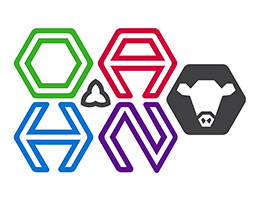Ontario Animal Health Network (OAHN) Bovine Expert Network Quarterly Veterinary Report
2024 Salmonella Dublin Report
During 2024, there were 35 lab diagnostic submissions to the AHL where Salmonella Dublin was detected on bacterial culture or PCR test (Figure 1). The submissions are estimated to represent 21 separate on farm outbreaks of disease from 19 unique farms. For 12 farms, this was their first diagnosis of S. Dublin (Figure 2). This compares to 16 outbreaks and 9 first premises diagnoses in 2023.
As of December 31, 2024, there are estimated to be 112 unique premises in the laboratory dataset that have had S. Dublin, of which 43 are veal, 58 are dairy, and 11 are from a beef operation. Submission identified as beef in 2024 were in dairy-beef cross calves.
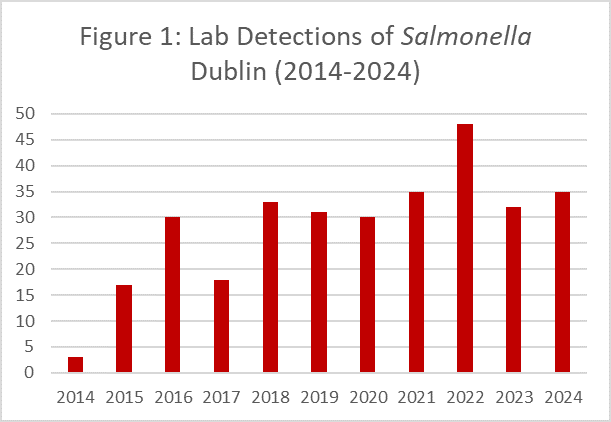

AVMA Video: Aseptic technique for blood culture collection in the field to diagnose Salmonella Dublin in calves
Research:
Exploring the impact and transmission of Salmonella Dublin in crossbred dairy calves
Higher biosecurity level was associated with reduced risk of Danish dairy cattle farms becoming test-positive for Salmonella Dublin
Q3 and Q4 Bovine Data from the Animal Health Laboratory
Q3: A total of 1666 bovine cases were submitted to the AHL during Q3, from Aug. 1, 2024 to Oct. 31, 2024. Of these, 177 submissions had a pathology component, consisting of 57 postmortem cases and 120 send-in cases (including 51 meat inspection cases).
Of these, there were 21 abortion/reproductive loss investigations: 10 idiopathic abortion, 5 bacterial abortion including 1 S. Dublin, 3 Ureaplasma, 1 Leptospira, 1 IBR, 1 congenital anomaly).
Regarding age distribution of the pathology cases, 34 were young calves (under 2 months of age), 30 older calves (2 months to 2 years of age) and 41 adult cattle.
Regarding commodity: 85 dairy, 59 beef, and 33 unspecified. 8 submissions had no specific diagnosis (in addition to the 10 idiopathic abortions).
Q4: A total of 1572 bovine cases were submitted to the AHL during Q4, from Nov.1 2024 to Jan. 31 2025. Of these, 206 submissions had a pathology component, consisting of 44 postmortem cases and 162 mail-in cases (including 58 meat inspection cases).
Of these, there were 23 abortion/reproductive loss investigations: 15 idiopathic abortion, 7 bacterial abortions (Trueperella, Streptococcus spp., Listeria), 1 congenital anomaly.
Regarding age distribution of the pathology cases (if provided), 33 were young calves (under 2 months of age), 40 older calves (2 months to 2 years of age) and 35 adult cattle.
Regarding commodity (if provided): 75 dairy, 51 beef, remaining were unspecified. Four submissions had no specific diagnosis (in addition to the 15 idiopathic abortions).
Interesting cases:
Bovine Cysticercosis (Taenia saginata) was detected in a meat inspection case containing suspicious lesions in the spleen and liver. Cysticercus bovis, the intermediate stage in the life cycle, was detected by histopathology and PCR/sequencing on samples leading to carcass condemnation.
Multidrug-resistant E. coli in 4-month-old calf, Holstein cross, beef
This calf presented with a history of neurological abnormalities and sepsis and was the fourth animal in the group to develop similar clinical signs at approximately 3-4 weeks following entry. Signs included sore joints, lateral recumbency with paddling and dull to stuporous mental status. There was no response to antibiotic treatment. The pathology findings noted were fibrinous polyarthritis, peritonitis and polyserositis.
Pure culture of Escherchia coli with whole genome sequencing of the isolate revealed it belongs to sequence type 23 (ST23) based on the Achtman scheme and is multidrug resistant based on the CARD database. Although the origin and clinical significance remain to be established, consultation with University of Montreal revealed the detection matches lineages of E.coli isolated from sick calves in Quebec.
There were 4 separate submissions for bison in Q4. Presenting animals ranged from 6 months to 3 years of age. The diagnoses included 3 cases of emaciation associated with parasitism and 1 case of Mycoplasma bovis pneumonia.
| Q3 | Q4 | |
| Salmonella | In total, 201 bovine submissions had bacterial culture performed (non-milk), generating 385 cultures. Salmonella spp. were isolated from 19 submissions | In total, 220 bovine submissions had bacterial culture performed (non-milk), 15 submissions included S. Dublin PCR. Salmonella spp. were detected in 12 submissions. |
|
Salmonella Dublin was isolated from 13 submissions from 9 premises. Affected animals were < 6 months; mostly associated with systemic infection, 1 abortion Salmonella Typhimurium was isolated from 3 submissions (1 septic cow, 1 calf enteritis, 1 no history) Salmonella Agona was isolated from 2 submissions (1 sick calf, 1 abortion) Salmonella Infantis was isolated from 1 submission (no history)
|
Salmonella Dublin – 6 submissions from 5 premises. (respiratory disease, septicemia, 1 GI signs) Salmonella Typhimurium – 1 submission (pneumonia 2yr old) Salmonella Agona – 1 submission (cow mortality) Salmonella Montevideo – 1 submission (no history) Salmonella Uganda – 1 submission (pneumonia/septicemia 10 month old) Salmonella sp. – 2 submissions (calf diarrhea, incidental finding) |
|
| Bovine Viral Diarrhea Virus (BVDV) | In total, 41 submissions had BVDV testing. 1 BVD case – 4 month beef calf GI disease (PCR+ IHC+). | In total, 41 submissions had BVDV testing. 1 BVD case – 4 month beef calf GI disease (PCR+ IHC+). |
This summary has been compiled by Dr. Andrew Brooks, Animal Health Laboratory (AHL) from diagnostic submissions to the AHL Guelph and Kemptville locations.
2024 Mastitis PCR Test Data for Ontario Lactanet Herds
Summary provided by Dr. David Kelton, U of G and Dr. Elouise Molgat, Lactanet
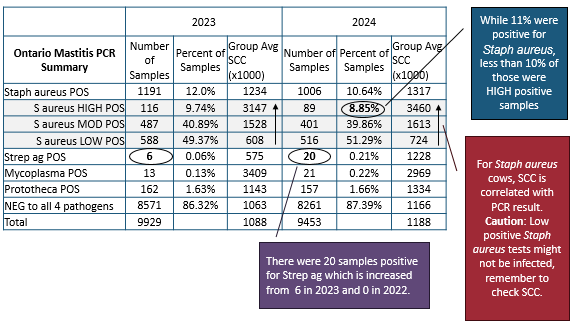
Somatic Cell Thresholds for Positive Samples (2024)
| Over SCC Threshold | Samples | 1 Million | Percent | 200K | Percent |
| Total Samples Over | 9453 | 3349 | 35.42% | 7560 | 79.98% |
| Staph aureus | 1006 | 397 | 39.46% | 909 | 90.36% |
| Staph High | 89 | 78 | 87.64% | 88 | 98.88% |
| Staph Mod | 401 | 218 | 54.36% | 392 | 97.76% |
| Staph Low | 516 | 100 | 19.78% | 429 | 83.14% |
| Strep Ag | 20 | 11 | 55.00% | 20 | 100% |
| Mycoplamsa | 21 | 15 | 71.43% | 20 | 95.24% |
| Prototheca | 157 | 84 | 53.50% | 148 | 94.27% |
Mastitis Pathogens from Milk Cultures Submitted to the Animal Health Laboratory in 2024 (MALDI-TOF)
Summary provided by Dr. Tanya Rossi and Dr. Durda Slavic
In 2024, there were 4,983 individual milk samples sent to the AHL.
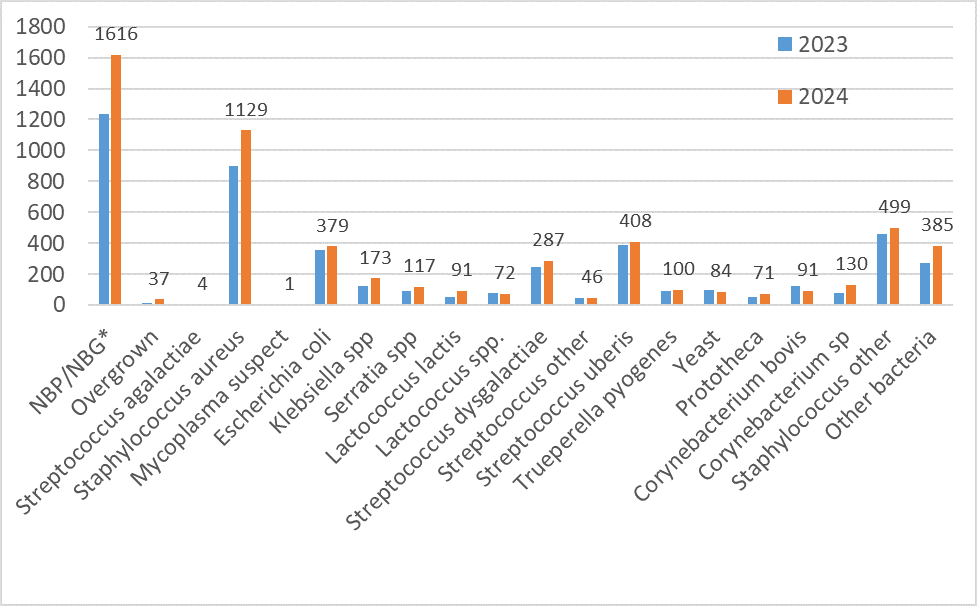
Moving to Selective Dry Cow Therapy by Dr. Elouise Molgat (Lactanet) and Dr. David Kelton (University of Guelph), Milk Producer Magazine, March 2025
“According to Lactanet 2024 data, nationally, just over half of the herds enrolled in milk recording would qualify as good candidates (herd level criteria) to not receive intrammary antibiotics at dry off. This has the potential to save on half the intramammary products on eligible farms, amounting to nearly half a million (480, 076) dry cow intrammary antibiotic tubes being saved at the national level.”
Read the complete article on pages 40-41 at https://milkproducer.ca/archive/2025-march/
Global Surveillance Update: Highly Pathogenic Avian Influenza (HPAI) in U.S. dairy cattle
Data updated May 26, 2025
- There have been 1,072 confirmed cases of HPAI in U.S. dairy herds (in 17 U.S. states) since the first bovine HPAI detection was confirmed in Texas in late March 2024.
- California has been the most impacted state, with 766 confirmed cases.
- Current phylogenetic and epidemiological evidence suggest this outbreak has involved three independent spillover events of HPAI virus from wild birds to cattle (taking place in Texas, Nevada, and Arizona, respectively). It is not known how the transfer of virus to cattle occurred in these events.
- In the last 30 days, there have been 38 new cases, from California (1/38), Arizona (1/38), and Idaho (36/38).
- The US has implemented a mandatory national surveillance strategy (the National Milk Testing Strategy (NMTS)) to support the identification and eventual elimination of HPAI in the US dairy herd. Per this program, 7 states are currently classified as affected (West to East: CA, NV, ID, AZ, TX, MN, MI), and 9 have met the criteria to be classified as unaffected (West to East: WA, WY, CO, OK, MS, AL, WV, PA, VT), with all remaining states (except for ND, FL and MA which have not enrolled in the National program), continuing to undergo surveillance and control measures to achieve unaffected status.
- In addition to identifying newly affected herds, the NMTS has resulted in the identification of a herd in Minnesota that was previously infected, quarantined, and released in July 2024. It was re-identified in March 2025 and was released from quarantine at the end of April.
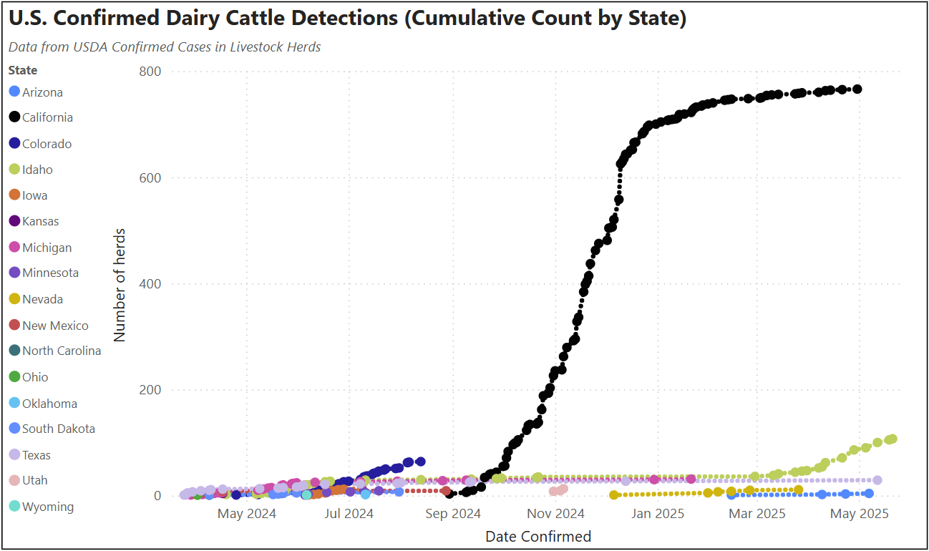
Key points for Ontario practitioners/producers
- There have been no cases of HPAI detected in dairy cattle or other livestock in Canada to date, but the risk of a Canadian dairy cattle outbreak remains due to continued circulation of the virus in American dairy cattle (predominantly the H5N1 B3.13 strain, and to a lesser extent, the H5N1 D1.1 strain) and wild birds (predominantly the D1.1 strain) throughout North America.
- HPAI in dairy cattle is a reportable disease to CFIA; instances of clinical suspicion must be reported to your local CFIA district office.
- Testing dairy cattle with clinical signs and/or compatible history with HPAI and testing dairy cattle prior to or following movement for biosecurity remain important measures. In both cases, CFIA will cover the cost of the laboratory fees.
- Infected cattle shed high levels of virus in their milk. Lactating dairy cattle entering Canada require a negative HPAI test and CFIA continues to test milk samples from trucks arriving to federal processing plants to monitor for an incursion. 970 Ontario truck samples have tested negative for HPAI through this program to date.
- There is no treatment or vaccine available for cattle infected with HPAI. Affected US herds have been provided with supportive care and implemented measures to prevent further spread, until recovered. Biosecurity measures remain the best way to protect herds.
Global Surveillance Update: European Foot and Mouth Disease (FMD) Outbreak
- Germany (January 2025): 1 case in a small, closed herd of extensively raised domestic water buffalo
- First case in Germany since 1988, origin of infection remains unknown
- Virus isolated was FMD Serotype O, closest match to an isolate circulating in Turkey in Dec 2024
- No further premises identified, no vaccination used. Germany’s FMD free status was reinstated by WOAH in April 2025
- Hungary (March 2025): 5 confirmed outbreaks (3 primary, 2 secondary) involving 9312 cattle and 9888 pigs
- First cases since 1973, origin of infection remains unknown
- Virus isolated was FMD Serotype O, 98-99% similar to isolation in Pakistan in 2017-2018 (different virus than the German outbreak)
- Slovakia (March 2025): 6 confirmed outbreaks (2 primary, 4 secondary) in commercial cattle holdings, involving 7,490 cattle
- First case since 1974, origin of infection remains unknown
- Virus isolated was the same as the Hungarian outbreaks (FMD Serotype O, 98-99% similar to isolation in Pakistan in 2017-2018)
- Hungary and Slovakia are working through confirmatory testing, suppressive vaccination (to control disease spread prior to culling), culling and disposal, disinfection, in addition to meeting surveillance and control requirements, for example (list not exhaustive):
- Testing of susceptible animals (domestic and wild) identified as contacts or in zones around infected premises
- Strict biosecurity measures on farms
- Movement bans of susceptible animals
- Closure of facilities with public display of susceptible animals, prohibition of markets/ exhibitions/events with susceptible species
- Checks at border crossings
- Public awareness campaigns
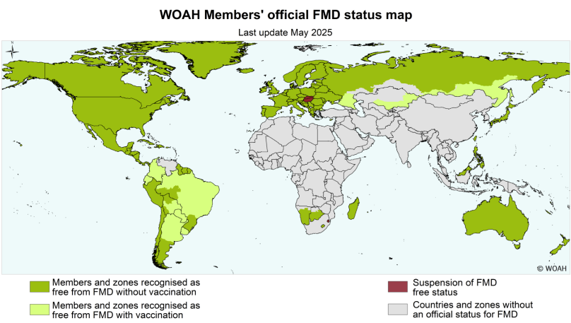
WOAH Members’ official FMD status map | World Organisation for Animal Health
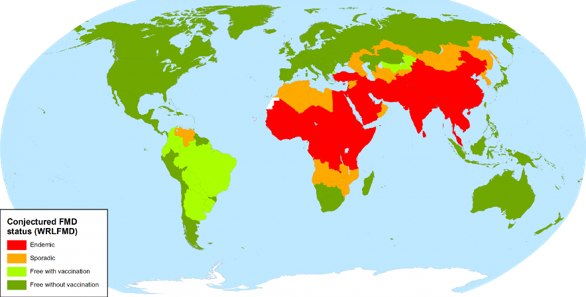
Global conjectured FMD status | World Reference Laboratory for Foot-and-Mouth Disease
Note: this map has not yet been updated to reflect the 2025 European outbreaks.
Key points for Ontario practitioners/producers
- FMD is a highly contagious virus affecting cloven-hooved animals (e.g. pigs, cattle, sheep, & goats).
- Clinical signs of FMD in cattle are often severe and include depression, anorexia, fever, milk drop, profuse salivation, teeth grinding and vesicles and ruptured lesions on the muzzle, inside the mouth, on feet and teats.
- Differential diagnoses for FMD in cattle include vesicular stomatitis, bluetongue, and malignant catarrhal fever, among others.
- FMD is present sporadically and endemically in multiple regions of the world. North America is considered free of FMD, though South America (Venezuela) is not.
- FMD virus is shed in infected animals’ breath, secretions and excretions, and animal products, making contaminated air, people, vehicles, equipment, feed, roads, milk, meat, and carcasses possible transmission risks.
- Risks for FMD incursions into free countries like Canada include the illegal entry of FMD contaminated meat and animal products into the country, and travel of people (e.g., workers or visitors) who have been in contact with FMDV.
- The last outbreak of FMD in Canada took place in Saskatchewan in 1951-52 involving 42 premises, resulting in the depopulation of ~1,300 cattle, ~300 pigs, ~100 sheep, and 1 goat. The origin of the outbreak was attributed to a worker from an infected farm in Germany who wore their contaminated clothes while working on the Canadian farm and was observed feeding dried sausage from Germany to pigs.
- If an outbreak were to happen today, Canada’s borders would close to susceptible animal/products trade and could take more than a year to re-open. FMD response would be led by the CFIA and involve stamping out the disease, movement controls, zoning/containment, and emergency vaccination to reduce spread in susceptible animals (if required)
In Canada, FMD is a reportable disease under the Health of Animals Act. All suspected cases must be reported to the CFIA. Learn more about FMD via CIFA’s factsheet.
New World Screwworm
New World Screwworm (NWS, Cochliomyia hominivorax) is a parasitic fly that attacks healthy tissue through wounds or orifices of livestock and wildlife, and sometimes people. In 2024 there was northward advancement of the fly with detections in Costa Rica, Nicaragua, Honduras Guatemala, Belize, El Salvador and now several farms in Mexico. In May 2025, the US Department of Agriculture suspended import of live cattle, horses and bison across the US-Mexico border due to the continued and rapid advancement.
Read more at: Press release: USDA Suspends Live Animal Imports Through Ports of Entry Along Southern Border
USDA Factsheet: New World Screwworm
Have an idea for an infographic you’d like to see, or a podcast you’d like to hear? Reach out to a network member or email oahn@uoguelph.ca.
AUG 2024 – JAN 2025
